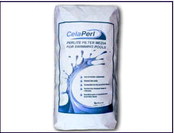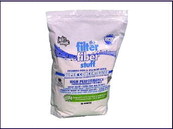reactions. Similar to activated carbon, the surface nano-structure adsorbs pollutants from the water. But unlike carbon, AFM is recharged by just backwashing with water.
AFM reduces the biological risk from bacteria and parasites as well as the chemical risk. AFM does not channel, so it is an effective barrier against Cryptosporidium and Giardia. AFM does not incubate or discharge bacteria and will reduce the bacterial load of the product water. Also because of the better filtration performance, there are fewer sanitation byproducts. AFM also provides an excellent solution to remove metals and heavy metals from water.
AFM is manufactured in a stateof- the-art hygienic factory designed by Dr. Howard Dryden, CEO and inventor of AFM. AFM contains metal oxide catalysts that dissociate oxygen and water to create a zone of high oxidation potential to prevent bacteria growing on the surface of AFM. In addition, the huge activated surface area has a strong negative charge for the adsorption of submicron particles and dissolved organic molecules. This makes AFM far superior to any other filtration medium because AFM does not need to be replaced and is recharged by a simple backwash.
Benefits at a glance
• More than doubles the performance of an existing filtration system without the need for additional investments.
• Is not subject to biodynamic instability and will never allow untreated water to pass the filter.
• Substantially lowers chlorine oxidation demand by up to 50 percent.
• Lowers backwash water demand by an average of 50 percent.
• Is expected to last for the life of the filtration system.
• Provides quick return on investment.
How to use
Replacing sand with AFM is simple, but it’s not a matter of just dumping it into the filter chamber.
First, check how much sand is required for the filter in question. Next calculate how much AFM is needed – because AFM has a lower bulk density, the quantity needed is reduced by 15%, or 85% of sand required. For example, if a filter requires 100 pounds of sand, add 85 pounds of AFM.
For filters of diameter smaller than 31 inches, add AFM in the following quantities: 50% AFM Grade 1 and 50% of AFM Grade 2. See accompanying graphic above.
For filters of diameter larger than 31 inches, add 50% Grade 1, 25% Grade 2, and 25% Grade 3.
Before filling the filter, check for damaged filter laterals. Half fill the filter with water to protect the laterals. Fill up the filter with AFM grades as determined above. The filter is ready. After installation, allow AFM to soak to get it wet or run pool equipment on filtration for 24 hours. Backwash after 24 hours. Backwash filter at least once a week.
Regenerative Media Filters
Regenerative media filters typically use perlite (or DE) as their filter medium and are capable of filtering dirt particles in the 1-to-5-micron range. Compared to the filtration capability of traditional sand filters in the 15-to-20-micron range, their filtration capability is excellent. They work by trapping particles on the surface of flexible tubes coated with perlite. When the perlite becomes
How to use AFM loaded, regenerative media filters regenerate by bumping, a process in which no water is lost.
Perlite is added to the filter through a slurry funnel. Then pool water is added into the tank and the perlite and water move toward outlet tubes, covered with polyester fabric, which becomes coated with the perlite medium, referred to as the precoat cycle. Water exiting from the perlitecoated filter is then clear, and filtration has begun.
Dirt particles collected by the perlite causes the pressure of the circulation pump to rise. This causes a bumping cycle to begin, where the outlet tubes covered with the perlite to shake the perlite off, which remixes the perlite back into the chamber before they re-adhere to the tubes with differently arranged perlite, which, though dirty, is still highly effective at filtering tiny particles.
After numerous cycles of filtering, bumping, and pre-coating, eventually a point is reached where even after a bumping cycle the pressure required to push more water through the filter is too great. At this point, it becomes necessary to dump out the entire slurry of water and dirty perlite in the tank, replace it with new, and the cycle begins again.
Among the greatest advantage of regenerative media filters is their filtration capability. Water filtered by regenerative media filters is truly crystal clear. Further, because they are capable of filtering exceptionally fine particles, users frequently report lower chemical use.
The other great advantage is in water savings, which is a big bonus, particularly in drought-prone regions. Backwashing the filter is not a part of routine maintenance. Rather, once the filter pressure becomes too great, and it is time to replace the perlite, only the volume of water of the filter tank is dumped. That water loss is much less than what is lost in backwashing, or in hosing a cartridge.
Commonly reported disadvantages include the upfront sticker price, which is certainly higher than traditional sand filters.
Secondly, they also require routine perlite replacements after several cycles of use. Compared to sand, which can last for years, some may find this a disadvantage.
Finally, they aren’t a great fit with high oil content. With highly used outdoor commercial pools, where the water sees a lot of sunscreen, regenerative media filters may not be the best option. Oils and lotions tend to cake the perlite, which will result in more frequent dumping cycles.
Cartridge Filters
Cartridge filters offer numerous advantages over sand and DE in that they are easy to maintain, ecofriendly in that they are water savers, and are easily replaced once they have reached their end of their useful life.
But not all cartridges are created equally, and knowing a bit about the components of a cartridge filter may help facilitate understanding which cartridges have superior filtration ability, durability, and provide greater energy savings.
The main components of a filter cartridge are the core, the filtration medium (fabric), the end caps, and the bands that hold them together.
Many manufacturers use a standard core, made of PVC pipe, with holes drilled through to allow water to flow through the core and fabric before returning filtered water to the pool. The core serves a couple of functions. First and foremost, it provides a scaffolding for the filtration fabric. Depending on the material of which it is composed, greater or lesser lifespans can be achieved. Depending on how open the core is, greater or lesser flow can be realized. Greater flow accomplishes three things. Greater flow means more filtration capacity. It also creates less wear on the circulation pump, and is associated with lower energy costs.
The filtration medium is the essence of the filter. Most standard filters use a Reemay tri-lobal filtration medium. The product is constructed of continuous, tri-lobal spun-bond fibers made of 100-percent polyester. It is made without acrylics, binders, or glue that can weaken and dissolve during use or cleaning. This process produces a rigid fabric that readily accepts and holds sharp pleats, providing excellent column strength. Further, the tri-lobal shape of the fibers maximizes the filtration surface area, and the continuous filament construction results in unsurpassed cleanability and durability.
Advances in filtration have led to “point bonded” filtration fabric. It is made with uniformly spaced weld spots, making it strong and capable of returning to a high degree of original performance after it is cleaned. It has more fibers per area, allowing for greater dirt-holding capacity.
Pleats
Pleating is extremely important in the fabric because it creates the peaks and troughs that catch the dirt. These pleats need to be sharp and precise for optimal flow and filtration capacity. All cartridge filters are pleated to a specific pleat count, and most are held together and around the core by three or four bands to keep the pleats even. These bands can break or stretch, which can allow the pleats to fall apart.
Advances in technology have resulted in some bandless cartridges, which hold the pleats in place on the inside at the core.
End caps
End caps hold the cartridge together and also act as a seal in the filtration caps on pool filters. Cheap end caps crack under pressure and result in a shortened lifespan. Tip: look for a company brand name and part number for quality filters.
DE Alternatives
DE Filters provide excellent filtration quality, filtering particulates in water from 3-5 microns, and are ubiquitous in residential application, but in spite of this, they are not universally loved, especially by pool service technicians.
The DE itself, composed of crystalline silicone dioxide, has been linked to health problems for users. It can be harmful to sensitive ecosystems. It’s messy to use. It doesn’t break down, and because it results in bridging between grids, doesn’t completely backwash and can be difficult to rinse away.
For these reasons and more, some service professionals prefer DE alternatives. Today, the popular choices are perlite and cellulose.
Perlite
Perlite is a natural product, produced by heating volcanic rock to extremely high temperatures, at which point it explodes and expands greatly, like popcorn.
It does this because upon heating, water trapped in the structure of the material vaporizes and escapes, and this causes the expansion of the material to 7–16 times its original volume. The expanded material is a brilliant white, due to the reflectivity of the trapped bubbles.
These perlite kernels are then ground down into a very lightweight powder for use in DE water filters as well regenerative media filters. Because perlite is so low density, generally only half the amount of powder is needed, compared to DE.
Proponents of perlite say that the light weight results in less bridging between grids, more complete backwashes, and longer filter cycles, as compared to DE.
Perlite is twice the cost of DE, but because half the weight is needed, you pay the same for the same filtration ability of 3-5 microns.
Cellulose
Cellulose fiber filter media is made of plant-based fibers – generally wood pulp.
It is natural, biodegradable, renewable, and non-toxic.
Cellulose fiber can be used as a replacement for DE, and it also makes a good filter aid for sand and cartridge filters, increasing their filtration ability and protecting filter cartridges.
Because cellulose can also trap oils, grease, and particles as small as 2 microns, unlike DE, it may clog up sooner.
Cellulose fibers can even clog up from the use of polymer chemicals, such as algicides, clarifiers, phosphate removers, or metal removers. These chemicals are not recommended for use with cellulose media.
Cellulose is the costliest of DE filter alternative – but it goes much further, only 6 ounces or .375 pounds is needed for each 10 square feet of filter area.
Cartridge Filters
To purchase CelePerl visit www.epminerals.com/products/celaperl
To purchase The Filter Fiber Stuff, visit www.jacksmagic.com/product/the-filter-fiber-stuff/


